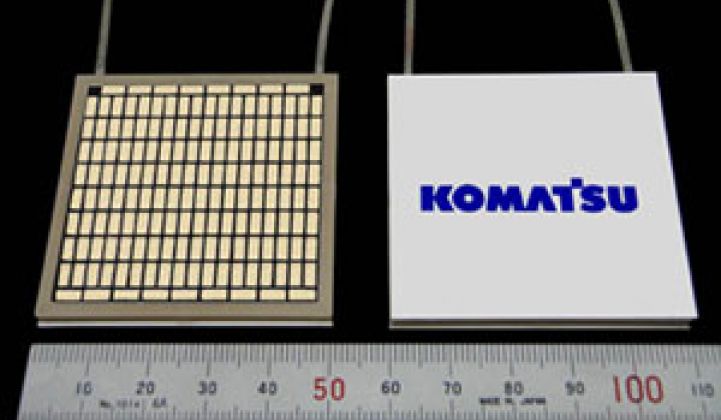Got heat? Komatsu will give you power.
The Japanese industrial giant will begin to take orders for a new, highly-efficient thermoelectric module that it says will take the heat from the inside of factories and under the hood of diesel vehicles and turn it into power. In the future, the company also hopes to develop materials that can exploit the heat contained in exhaust gases from bulldozers and construction equipment to create electricity.
The modules are made out of bismuth telluride and will convert about 7.2 percent of the ambient heat into electricity. That's about 50 percent higher than existing products, the company says.
To work, the heat has to be between 280 and 250 degrees Celsius. A standard module will cost around $320 and produce 24 watts. Improvement in price and output will occur over time.
Waste heat isn't the most glamorous segment in greentech, but it's got promise, according to advocates. In the U.S., approximately 55 percent to 60 percent of the energy produced gets dissipated as waste heat, according to U.C. Berkeley. Tapping into it could reduce greenhouse gases, energy consumption and energy prices.
Some companies, such as Recycled Energy Development (RED) in Illinois, China Energy Recovery and Ormat in Israel exploit waste heat by trapping it, pressurizing it, and then using it to turn a turbine or heat water. In West Virginia, RED is building a system that will produce 45 megawatts of electricity from waste heat coming from a silicon factory. CER, meanwhile, just landed an $8.9 million project with the Sopo Group in Jiangsu that will displace about 17,000 tons of coal a year.
Komatsu and others, however, are trying to move beyond these more traditional and time-tested techniques to use semiconductors to trap and convert heat. Cypress Semiconductor, which made billions by investing in SunPower, has already set up a division to explore thermoelectrics (see Green Light post). It is working with scientists from U.C. Berkeley. The university also has a spin-off. Instead of using bismuth telluride like Komatsu, the Californians are experimenting with gallium arsenide. Potentially, these devices could be used inside cars.
Meanwhile, in Massachusetts, GMZ Energy and Promethean Power (which received investment from the Quercus Trust) are developing thermoelectric for, respectively, industrial use and refrigeration in the third world.



